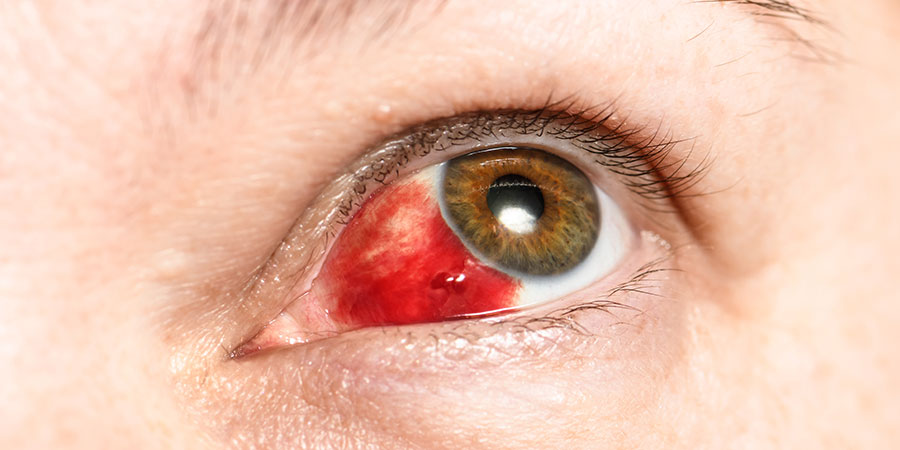What are the symptoms of a subconjunctival hemorrhage?
A subconjunctival hemorrhage occurs when a small blood vessel in the conjunctiva (the clear membrane covering the white part of the eye) breaks, causing blood to leak into the space between the conjunctiva and the sclera (the white part of the eye). The symptoms of a subconjunctival hemorrhage can include:
Visible Symptoms
- Red Spot on the Eye: A bright red or dark red patch on the white part of the eye, which may appear suddenly and can cover a small or large area.
Sensory Symptoms
- No Pain: Typically, a subconjunctival hemorrhage is not painful. Most people do not experience discomfort or irritation.
- No Change in Vision: Vision usually remains unaffected. If there is vision change, it may be due to another condition or an underlying issue.
Other Symptoms
- Mild Irritation: Some people may experience a slight feeling of irritation or a scratchy sensation in the eye, though this is not common.
- Tearing: Slight tearing or watery eyes may occur.
Subconjunctival hemorrhages are often harmless and resolve on their own without treatment. However, if the bleeding is recurrent, associated with pain, changes in vision, or if there are underlying health concerns, it is important to consult a healthcare provider to rule out other conditions or causes.
What are the causes of a subconjunctival hemorrhage?
A subconjunctival hemorrhage occurs when a small blood vessel in the conjunctiva bursts, leading to bleeding in the white part of the eye. Common causes include:
1. Trauma
- Injury: Direct trauma or injury to the eye or surrounding area, such as a punch, scratch, or rubbing the eye vigorously.
2. Increased Pressure
- Coughing: Intense coughing or sneezing can increase pressure in the blood vessels and cause them to burst.
- Straining: Heavy lifting, straining during bowel movements, or childbirth can also increase pressure in the blood vessels of the eye.
3. Medical Conditions
- Hypertension: High blood pressure can make blood vessels more prone to rupture.
- Blood Disorders: Conditions that affect blood clotting or blood vessel integrity, such as hemophilia or thrombocytopenia.
4. Medications
- Anticoagulants: Use of blood-thinning medications, such as warfarin or aspirin, can increase the risk of bleeding.
- Other Medications: Certain medications can have side effects that make blood vessels more susceptible to bleeding.
5. Infections
- Conjunctivitis: Inflammation or infection of the conjunctiva can sometimes lead to bleeding.
6. Eye Conditions
- High Myopia: Severe nearsightedness can increase the risk of subconjunctival hemorrhage.
- Eye Surgery: Recent eye surgery or procedures may result in subconjunctival bleeding.
7. Spontaneous Occurrence
- Idiopathic: Sometimes, a subconjunctival hemorrhage occurs without a clear cause and is considered idiopathic.
In most cases, a subconjunctival hemorrhage is benign and resolves on its own without treatment. However, if it is recurrent, associated with pain, vision changes, or other symptoms, it’s important to consult a healthcare provider to rule out underlying conditions or complications.
What is the treatment for a subconjunctival hemorrhage?
Treatment for a subconjunctival hemorrhage is generally minimal, as the condition often resolves on its own without medical intervention. However, there are some steps you can take to manage the symptoms and support healing:
1. Observation and Time
- Natural Resolution: In most cases, a subconjunctival hemorrhage will gradually fade and resolve on its own over a few weeks. Monitoring the condition is usually sufficient.
2. Lubricating Eye Drops
- Relief of Discomfort: If there is any mild irritation or dryness, over-the-counter lubricating eye drops (artificial tears) can help soothe the eye.
3. Avoiding Irritants
- Gentle Care: Avoid rubbing or scratching the eye, which can exacerbate the condition or cause further irritation.
4. Managing Underlying Causes
- Addressing High Blood Pressure: If the subconjunctival hemorrhage is related to high blood pressure, managing and controlling blood pressure is important.
- Review Medications: If you are taking anticoagulants or other medications that may contribute to bleeding, consult your healthcare provider to discuss potential adjustments.
5. Avoiding Strain
- Minimizing Physical Stress: Avoid activities that could increase pressure in the eyes, such as heavy lifting, straining, or vigorous coughing.
6. Applying a Cold Compress
- Comfort: Applying a cold compress to the eye may provide comfort and reduce any mild swelling or discomfort.
7. Seeking Medical Attention
- Consultation: If the subconjunctival hemorrhage is accompanied by pain, vision changes, frequent recurrences, or if it does not improve over time, seek medical attention to rule out other conditions or complications.
Most subconjunctival hemorrhages are harmless and resolve without specific treatment. However, addressing any underlying conditions or contributing factors is important for overall eye health and well-being.

Leave a Reply
You must be logged in to post a comment.